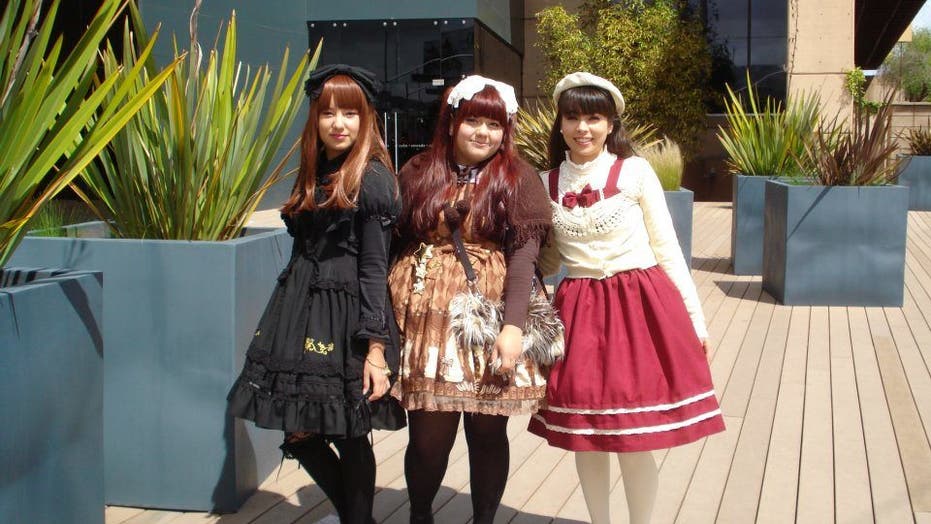When people think of the vacationing resorts, or the crime ridden streets of Mexico, they don’t envision seeing young women casually strolling through malls like Plaza Rio in downtown Tijuana dressed modestly in Victorian-era clothing. Twenty-something’s dressing in what’s called “Lolita Fashion”—a Japanese inspired style they say fits who they feel they really are.
“We’re pleasing ourselves not the world. It makes me feel free. Showing myself in a different way,” says Daniella Michel, a Graphic Designer, who started the Lolita Facebook forum in 2008, and now has over 1,000 Friends or Lolitaphiles.
Like most hobbies, Lolita fashion enthusiasts are exact in achieving perfection--down to the very last petticoat. Lolita girls spend hundreds of dollars on their outfits, not including the cost of shipping from Japan---which is where any self-respecting Lolita cops her garb.
Inspired by the Rocco or Victorian-eras, the average Lolita costume consists of a jumper dress worn over a long-sleeve lace top. The skirt is a cupcake or bell- shape, assisted by crinoline. Underneath, they wear white cotton petticoats, knee socks or stockings, Mary Jane shoes, some kind of headpiece like a bow or beret, and their hair worn in bangs.
With several different styles of Lolita’s to choose from, the most popular ‘”Classic” is a lady-like and more mature look, with romantic fabrics, usually in earth tones. The waistline is dropped, and the shape more A-line than bell.
“Gothic” Lolita’s are bittersweet, using a bit darker print than the other styles, with the addition of a crucifix as accessory.
The “Sweet” Lolita wears dresses in fabrics with images of food, bunnies, flowers, or fruit—a more fantasy Alice in Wonderland kind of theme.
Not to be left out of the scene, a few boys are into Lolita as well—calling themselves “Brolitas”. They dress like the girl versions. There’s also “Oji” aka “Prince” Lolita, they dress like Victorian boys--this style can be worn by both genders.
Immediately dispelling the misnomer that Lolita fashion has anything to do with Vladimir Nabokov’s 1955, famed book by the same title, Stephanie Gonzalez says, “We’re not related at all to that character. Lolita in the book wants to look and act more adult. We’re the opposite. We accentuate the sexy without the traditional concept of sexuality. We want to be beautiful and elegant. But we’re older trying to look younger.”
The fashion of Lolita dates back to the 1970’s when Japanese clothing brands like Pink House and Milk and Pretty began selling clothing in the style.
It became a subculture of fashion given rise from the popularity of both Anime and the early 90’s Japanese girl pop/rock J music band Princess, Princess aka Puri-Pun.
For the Lolita women, their style goes against popular trends. It’s what they consider the opposite of the Kardashian—nothing tight and nothing revealing.
“The girls in TJ run around with their bellies exposed and boobs hanging out. The irony is the dresses we wear are made for Japanese girls with small busts. We don’t like big busts. They make the dresses difficult to fit into,” says Sandra Gonzalez.
The women say social media has been the great connector for them. They’ve found women around globe who share their love of Lolita—From Brazil to Chile, to Israel, and even Arab countries--the women swear there are even Muslim Lolita’s who wear bows even with faces veiled.
Daniella Michel, CEO of the My Lolita Style website, the first Lolita site in Spanish, was so determined to push the agenda of their group, for the last two years she’s been working on the committee of “ComCom”, TJ’s version of Comic Con. In March 2012 the convention had over 5,000 attendees, held at the Camino Real hotel in the TJ’s financial district.
Though it’s 7,000 miles from Harajuku, Japan to Baja, Mexico, Lolita’s a style that makes these Latina women feel most at home in their own skin.
“Like a person struggling with a sex change and feeling like they’re born in the wrong body, when I found Lolita, it was as if I was born in the wrong century. I dress this way to feel like me,” Paulina Contreras says.
The main concern the women have is that people understand they don’t dress like this to sublimate their sexuality, but to take control of it.
“We’re choosing to dress like this. You have to have a secure, confidant, and most of all fierce attitude dress in Lolita,” Fatima Kato says.


